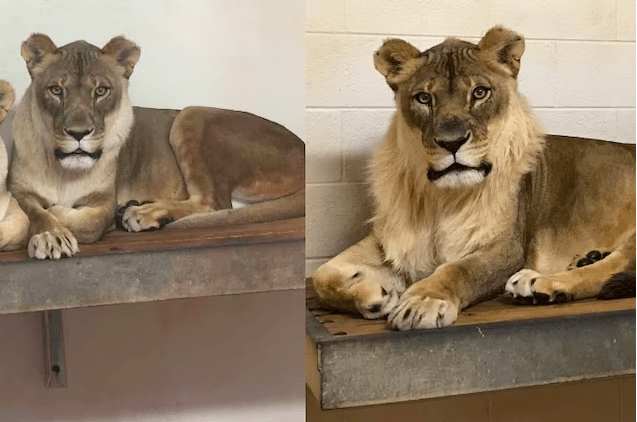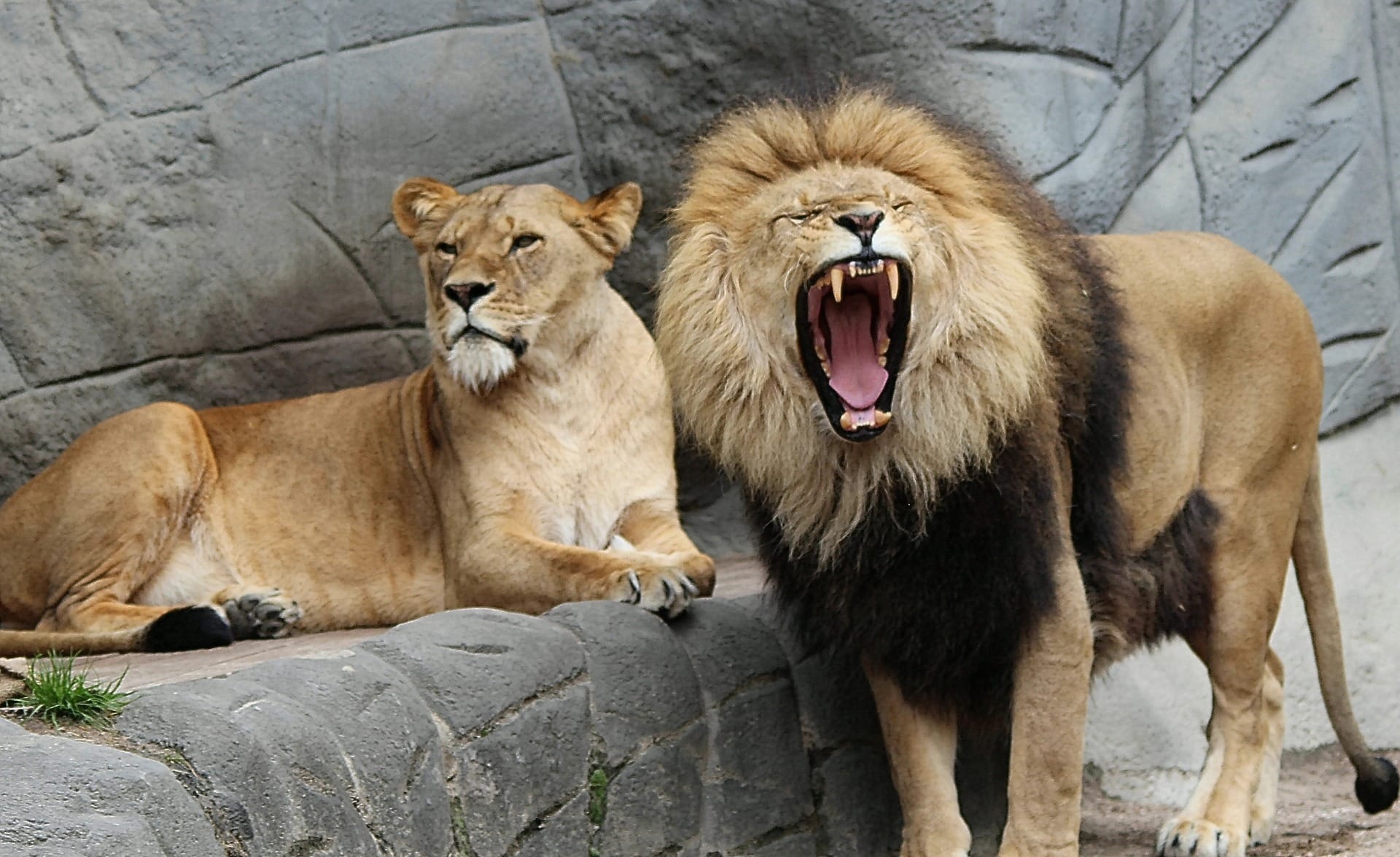There is a widespread belief that only lions have a lush mane, and lionesses cannot boast of such a beautiful hairstyle. We decided to check what scientists know about this.
To the potential manes of lionesses, many internet users show interest at discussion Soviet animated film "Boniface's Vacation", in which the grandmother of the main character had a very pronounced mane. This gave rise to a wide variety of suspicions: perhaps she is a transfeminine lioness or even a grandfather-crossdresser. This theory is quite popular: for example, fast in the “Lepra” community on VKontakte received more than 22,000 likes and more than a thousand reposts. They doubt the gender identity of Boniface’s grandmother and the media (Lenta.ru — “They spotted a transvestite in Lion Boniface’s grandmother*”), and entertainment portals (Adme — “11 blunders in our favorite cartoons that we noticed only now,” Pikabu - “And the lion’s grandmother Boniface is a male”). Users of sites with questions And answers.

Boniface and his grandmother. Artist S. Alimov, set of postcards Source
Anatomical differences between males and females of the same species are called sexual dimorphism. Dimorphism may be permanent or occur only during courtship and mating. Most often, dimorphism is expressed in externally noticeable characteristics: a different color and size or a different structure of individual parts of the body. This is logical, since it serves primarily to attract the attention of the opposite sex. However, there is also exceptions: for example, males of the three-spined stickleback Gasterosteus aculeatus and newt Triturus viride-scens differ from females in the size of their kidneys, and male South Asian fish of the genus Psilorhynchus have a much larger swim bladder and have a more complex structure than that of females.

In many cases, males are larger, more brightly colored, or have additional growths or growths. However, in some species the females are larger or brighter. For example, at deep sea anglerfish Ceratias holboelli females are 120 cm long, and males are only 16 cm. During mating, the male literally grows to the female and remains attached to her for life. This solves two problems of these deep inhabitants at once: finding a partner in almost complete darkness and providing food.
Lions' manes are also an example of sexual dimorphism. Scientists believethat lions were originally maneless, and acquired a chic hairstyle 190,000 - 320,000 years ago. Mane grows up in lions entering puberty, which is approximately one year of age. Scientists suggestthat the mane has three important functions: it serves as a kind of protection in battle, allows information about the individual’s fighting ability to be transmitted to other members of the species, and attracts the opposite sex. Craig Packer, professor of ecology, evolution and behavior at the University of Minnesota in 2004 provedthat the color and length of the mane play an important role in the hierarchy. For the experiment, four lion dummies were made: “short-haired blond” Lothario, “blonde with a long mane” Fabio, “short-haired brunette” Romeo and “long-haired brunette” Julio. These dummies were then placed in the wild, monitored by cameras, and scientists assessed how real lions would try to interact with their new lions. The females clearly preferred the brunettes Romeo and Julio, demonstrating sexually active behavior, while the males tried to avoid them, but attacked Lothario and Fabio, lions with blond manes.

At the same time, lions have no or minimally pronounced mane meet and now. Most of these individuals can be found in Kenya's Tsavo National Park. Scientists explain their difference from other representatives of the species by other climatic features - in an extremely hot climate, it is easier for lions to do without luxurious decoration. Moreover, in a savannah with thickets of thorny bushes, the mane will only interfere with hunting, as it will constantly get tangled in the branches. However, not only in Kenya there are maneless lions, they meet also in Benin, Sudan and Senegal.

By © Micho2020 / CC BY-SA 4.0, Link
In addition to climate, manelessness can be caused by other factors. In particular, supposed, which plays a role in the increased level of the male sex hormone testosterone, which in humans indirectly may lead to baldness. This hypothesis is indirectly confirmed by the fact that castrated lions stop produce testosterone and quickly lose their mane.
Thus, a lion without a mane is a rare phenomenon, but it does not represent a pathology. But can there be a lioness with a mane? As some descriptions indicate, maybe. In 2016, scientists published article in the African Journal of Ecology, which talked about five lionesses from Botswana who acquired manes.

In addition to having a mane, a lioness demonstrated male behavior - they marked their territory in a characteristic way, emitted a “male” roar, did not become pregnant, although they mated with males, and also tried to have sexual intercourse with females. Moreover, one of the observed lionesses, designated by scientists as SaF05, killed two of the thief's lion cubs in retaliation for stealing the carcass of a zebra she had hunted. This behavior is extremely uncharacteristic of females, but is common in males. Scientists have suggested that the issue is increased testosterone production (possibly, since we are talking about one population, genetically determined). This correlates with the fact that women often have high levels of male hormones becomes the cause of anovulation (lack of ovulation during reproductive age), which, in turn, leads to the inability to get pregnant.
However, usually the appearance of a mane does not occur in several individuals in a pride at once, but in one. For example, in 2011 Emma, a lioness from a zoo in South Africa, began to develop a mane in her 13th year of life. Doctors found outthat the reason was a malfunction of her ovaries, they performed an oophorectomy on the animal - an operation to remove the ovaries, and gradually Emma’s mane fell out. The lioness was not infertile; she had previously become pregnant and given birth successfully.
In 2017 mane acquired 18-year-old lioness Bridget from the Oklahoma City Zoo in the USA. Doctors assumed that it was testosterone again, but they were wrong. Bridget's testosterone levels were no different from the norm and from the level of this hormone in the blood of her sister Tia. However, Bridget had much higher levels of cortisol and androstenedione, which are produced by the adrenal glands. Scientists have suggested that the cause of these changes is a hormone-secreting benign tumor in one of the lioness’s adrenal glands. Unfortunately, in April 2018, Bridget had to be euthanized due to developing heart failure.

At the end of 2020, the mane became adopt Zuri, an 18-year-old lioness from the Topeka Zoo in Kansas. Earlier, in October, a male lion at the zoo died, and since then the females have found themselves in an all-female pride. A blood test for hormones was not taken from Zuri, but she is in good shape for her age - she has kidney disease and arthritis, which are typical for older cats, but both pathologies are under the control of doctors. At the same time, scientists do not see a clear connection between an all-female pride and a grown mane. “I don't think there's really any evolutionary [reason for this], whether it's a lack of males, or too much competition with other females, or something like that. I think it's just a coincidence." said Chris Everatt is an environmental scientist with the global wild cat conservation organization Panthera.
Thus, lionesses with a mane are a phenomenon, although not as common as maneless lions, but they are found both in the wild and in zoos. The reasons for the appearance of manes in females have not been fully studied by zoologists; among those already identified are some endocrine disorders. It is also possible that genetics or the absence of a male in the pride plays a role. Transferring the data known to science to a cartoon, Grandma Boniface with a mane looks unusual, but this does not indicate that she is a transfeminine lioness or a crossdresser. Perhaps she has a benign tumor of the adrenal glands or age-related disorders in the functioning of the ovaries, or maybe she is just a widow, because there is not a word about grandfather Boniface in the cartoon.
*To convey the context, we used a verbatim quote with an incorrect and outdated word from the original source. “Verified” does not support linguistic discrimination and in materials where the editorial position is expressed, it uses neutral expressions recommended by the directory "We don't say that", in particular not “transvestite”, but “crossdresser”.
Cover image: Frauke Feind from the site Pixabay
Not true
Read on the topic:
- Is it true that elephant tusks and rhinoceros horns are painted pink to save these animals from poachers?
- Is it true that elephants are the only mammals that cannot jump?
- Is the photograph of an elephant carrying a lion cub in its trunk true?
- Is it true that zebras need stripes for camouflage?
- Is it true that elephants are afraid of mice?
- Myths about the Metro-Goldwyn-Mayer film studio's lion screensaver
If you find a spelling or grammatical error, please let us know by highlighting the error text and clicking Ctrl+Enter.






